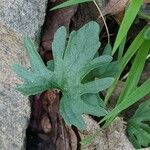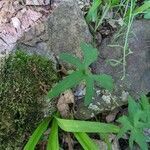Plants perennial, acaulescent, not stoloniferous, 6–50 cm; rhizome thick, fleshy. Leaves basal, 2–3, ascending to erect; stipules linear-lanceolate, margins entire, apex acute; petiole 1–20 cm, glabrous or pubescent; earliest leaf blades unlobed, mid-season blades 3–9-lobed, lobes sometimes appearing petiolate and sometimes further lobed; earliest leaf blades reniform to ovate, mid-season blades with middle lobes usually ovate or elliptic to widely obovate, sometimes narrowly elliptic, narrowly ovate, lanceolate, or spatulate to narrowly obovate, lateral lobes elliptic, obdeltate, or spatulate to falcate, smaller lobes similar, 1–14 × 1–10 cm, base truncate to cordate, margins serrate or entire, usually ciliate, apex acute, rounded, blunt, or obtuse, surfaces glabrous or pubescent throughout or along veins. Peduncles 3–13 cm, glabrous or pubescent. Flowers: sepals lanceolate, margins ciliate or eciliate, auricles 0.5–1 mm; petals violet on both surfaces, lower 3 white basally, lower 3 and upper 2 sometimes purple-veined, lateral 2 bearded, spur sometimes bearded, lowest 15–25 mm, spur white, gibbous, 2–3 mm; style head beardless; cleistogamous flowers on prostrate to ascending peduncles. Capsules ellipsoid, 5–15 mm, glabrous. Seeds beige, mottled to bronze, 1.5–2.5 mm. 2n = 54.
A herb. It keeps growing from year to year. It has a thick, long underground stem or rhizome. The leaves are 5-12 cm long. They are widest near the base and have 5-11 lobes. There can be teeth along the edge. The flowers are reddish-violet. They occur singly at the top of the flower stalk. They are 2-5 cm across. They have 5 petals and the side ones have a short spur to the back. The fruit is an oval capsule. It is 5-15 mm long.


